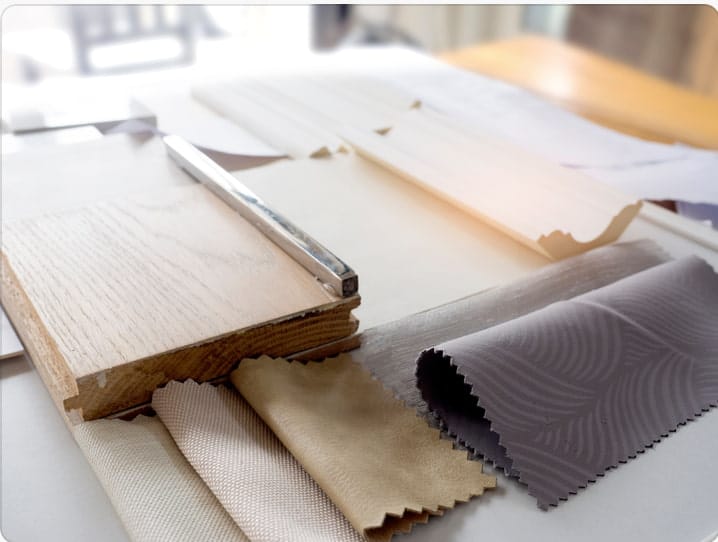What is Laminated Fabric Made Of?

Laminated fabric is a versatile material that can be used for a variety of purposes. It’s strong, water-resistant, chemical-resistant, and durable, making it a great choice for many different applications.
Laminated Fabric is Bonded Fabric
Laminated fabric is made of two or more layers of fabrics that are bonded together with an adhesive. This construction creates a fabric that is stronger and more durable than traditional fabrics. Laminated fabrics are often used in applications where strength and durability are important, such as in the construction of tarps and tents. However, laminated fabrics can also be used for more decorative purposes.
For example, laminated cotton fabric is often used to make quilts and purses. The adhesive used to bond the layers of fabric together can also be used to add embellishments, such as ribbon and trim.
Laminated Fabric Has At Least Two Layers
Laminated industrial fabrics are created by bonding two or more layers of fabric together using heat, pressure, or adhesive. The top layer of laminated fabric is usually a thin, often decorative fabric, while the bottom layer is a thicker, more durable fabric. This construction helps to improve the strength and durability of the laminated fabric while also providing a surface that is resistant to tearing and abrasion.
In addition, laminated fabrics are often used in applications where they will be exposed to extreme temperatures or harsh chemicals like a hazmat suit or space suit. By bonding the layers of fabric together, laminated fabrics are able to resist these conditions better than non-laminated fabrics.
Laminated Fabric is Great For Heavy Duty Use
The nature of laminated fabric makes the fabric stronger and more durable than unlaminated fabric. In addition, laminated fabric is often treated with a water-resistant coating, which helps to repel moisture and stains. As a result, laminated fabric is an excellent choice for a variety of applications, from light-duty items like tarps and raincoats to heavy-duty items like upholstery and industrial materials.
Laminated Fabric Has Other Uses, Too
Laminated fabric is a type of material that has been treated to resist moisture, wear, and stains. It is commonly used for a variety of purposes, such as upholstery, clothing, and outdoor gear. The most common type of laminated fabric is made with a layer of vinyl or PVC and a layer of fabric, but there are also laminated fabrics made with paper, metal foil, and even tarpaulin. Laminated fabric is available in a wide range of colors and patterns, and can be printed with any design.
Other applications include:
- Tents
- Rafts
- Safety vests and life vests
- Army surplus dry bags
- Heat sealable ballistic covers
- Anti-G bladders
- Aluminized fabrics for radiant heat protection
- Diving buoyancy compensator vests
- Escape slides
What Industries Use Laminated Fabric?
Laminated fabric solutions are a tremendous asset for many industries; from fashion to healthcare, the options provided by these versatile products deliver outstanding results. With custom development capabilities and multiple types of textiles/films available, laminated fabrics can add power-packed performance potential in key areas:
- Recreation: Our special laminate materials make sports and recreation even more fun. Whether it’s for SCUBA diving, swimming or rafting adventures – our fabrics are designed to keep you safe by helping with buoyancy control and providing extra padding during active games!
- Defense: Our innovative laminated fabrics are essential to military operations around the world, providing crucial protection and comfort in a range of scenarios. From reinforcing Navy life rafts against harsh weather conditions to enhancing armor flexibility with heat sealable soft packets or keeping troops warm on missions through stuff sacks for modular sleep systems – our defense fabric solutions play an integral role in success stories worldwide.
- Aerospace: This industry soars to new heights with the manufacture of fabrics for thermal protection and survival systems. Our laminates are essential in aircraft, while our FAA-certified materials ensure safety devices like life vests, escape slides/rafts and liquid storage bladders perform as needed.
- Medical: Medical-grade laminated fabrics are the go-to material for airtight applications, offering a secure environment ideal for blood pressure cuffs and infusor bags. APM or Alternative Pressure Mattress for instance, uses a system of air bladders to help patients recover from bedsores and pressure sores. For hospital and healthcare workers on the frontline of treating infectious diseases, a medical isolation chamber provides added protection to staff members caring for virus-ridden patients while keeping health risks at bay.
- Automotive: Automotive solutions are at the cutting edge of modern design, incorporating innovations and ground-breaking technology from motorsport. Weight reduction plays a major role in maximizing efficiency; manufacturers use advanced fabrication techniques to craft lighter fuel tanks and bladders that contribute to unbeatable performance seen on some of the world’s fastest cars. Hybrid technology is pushing technological boundaries even further – demanding ever more efficient designs with reduced weight packaging for optimal vehicle functioning. Automotive industries have tapped into our bladder technology to ensure the most reliable performance when it comes to critical components like fuel, oils, water and coolants. But beyond that, this same cutting-edge tech is also being used for creating safer vehicle environments; from airbags designed to cushion collisions to ergonomically sound lumbar supports in car seats.
Can Laminated Fabric Be Recycled?
Many of us are familiar with the benefits of recycling, but what about items that can’t be recycled through traditional means? Laminated fabric is one such example. Most types of fabric can be recycled through textile recycling programs, but laminated fabric is typically excluded because the laminate can’t be removed.
However, there are a few companies that specialize in recycling laminated fabric. The process starts by shredding the fabric into smaller pieces. The laminate is then separated from the fabric, and the two materials are recycled separately. The end result is a recycled product that can be used to create new laminated fabric or other products.
With experience with laminated fabrics, RF welding, and custom industrial sewing services, Vinyl Technology proudly manufactures custom-made products for a variety of industries. Our dielectric sealing and custom sewing product customers choose us because, above all, we deliver safe and reliable products.
If you are looking for custom RF welding and RF Sealing services, PVC sealing or looking for custom industrial sewing, please contact us today.

